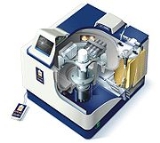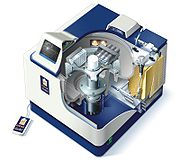
Centrifugal evaporator
Encyclopedia

Rotary evaporator
A rotary evaporator is a device used in chemical laboratories for the efficient and gentle removal of solvents from samples by evaporation...
is most often used. The most advanced modern centrifugal evaporators not only concentrate many samples at the same time, they eliminate solvent bumping
Bumping (chemistry)
Bumping is a phenomenon in chemistry where liquids boiled in a test tube will superheat and, upon nucleation, rapid boiling will expel the liquid from the container....
and can handle solvents with boiling points of up to 220 °C. This is more than adequate for the modern high throughput laboratory.
Design
A centrifugal evaporator often comprises a vacuum pumpVacuum pump
A vacuum pump is a device that removes gas molecules from a sealed volume in order to leave behind a partial vacuum. The first vacuum pump was invented in 1650 by Otto von Guericke.- Types :Pumps can be broadly categorized according to three techniques:...
connected to a centrifuge chamber in which the samples are placed. Many systems also have a cold trap
Cold trap
In vacuum applications, a cold trap is a device that condenses all vapors except the permanent gases into a liquid or solid. The most common objective is to prevent vapors from a vacuum pump from contaminating the experiment or sample of interest. Cold traps also refer to the application of cooled...
or solvent condenser placed in line between the vacuum pump
Vacuum pump
A vacuum pump is a device that removes gas molecules from a sealed volume in order to leave behind a partial vacuum. The first vacuum pump was invented in 1650 by Otto von Guericke.- Types :Pumps can be broadly categorized according to three techniques:...
and the centrifuge chamber to collect the evaporated solvents. The most efficient systems also have a cold trap on the pump exhaust. There are many further developments available from manufacturers to speed up the process, and to provide protection for delicate samples.
The system works by lowering the pressure in the centrifuge system - as the pressure drops so does the boiling point of the solvent(s) in the system. When the pressure is sufficiently low that the boiling points of the solvents are below the temperature of the sample holder, then they will boil. This enables solvent to be rapidly removed while the samples themselves are not heated to damaging temperatures. High performance systems can remove very high boiling solvents such as DMSO or NMP while keeping sample temperatures below 40 oC at all times.
The centrifugal force generated by spinning the centrifuge rotor creates a pressure gradient within the solvent contained in the tubes or vials, this means that the samples boil from the top down, helping to prevent "bumping". The most advanced systems apply the vacuum slowly and run the rotor at speeds of 500 x gravity - this system is proven to prevent bumping and was patented by Genevac
Genevac
Genevac Ltd is a company which was founded in 1990 by Michael Cole. It used to specialize in the manufacture of vacuum pumps and centrifugal evaporators, but has since directed its attention to equipment designed for combinatorial chemistry. Following a series of mergers, it is currently a...
in the late 1990s.

